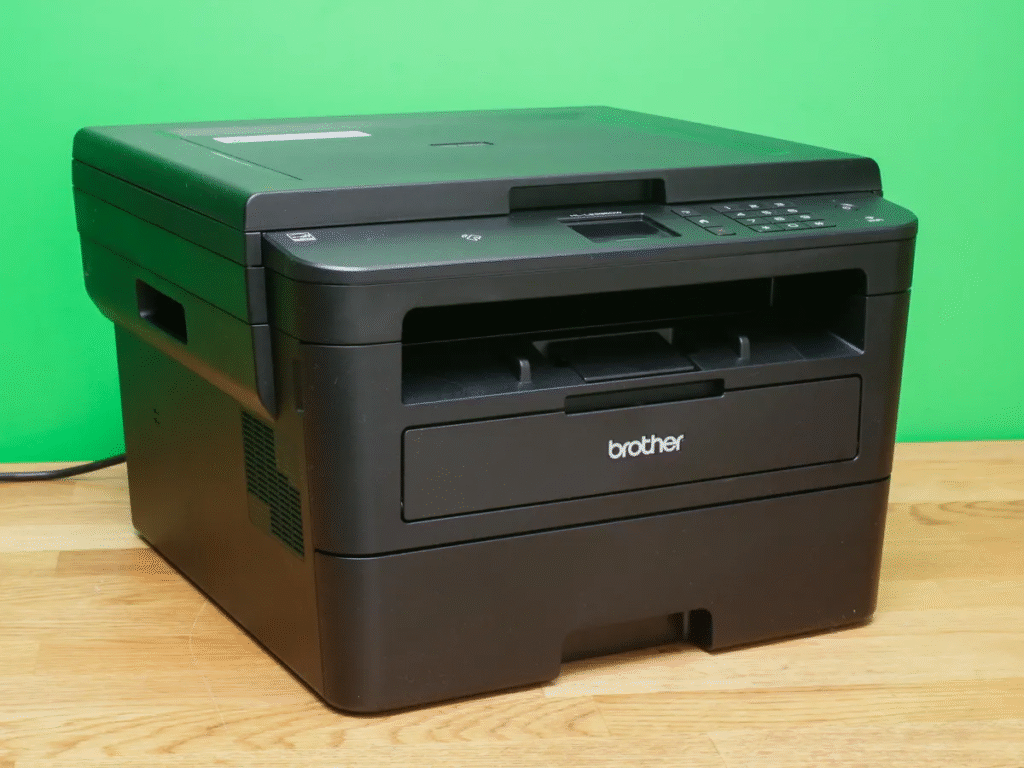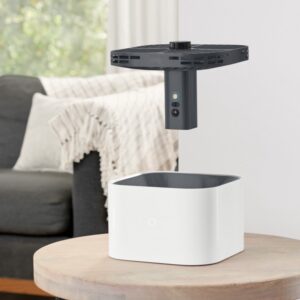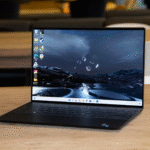When we started testing printers at bestforhomeuse.com, our goal wasn’t to find the biggest or fastest machine, but the most practical home printer for home use—a model that fits into everyday routines.
We learned quickly that not every printer marketed for homes actually works well in a family setting.
For example, some looked compact but had high ink costs, while others offered great photos but jammed too easily with bulk school assignments.
Through side-by-side testing, we identified what really makes a reliable home printer for home use: consistent output, wireless convenience for multiple devices, and reasonable long-term running costs.
What stood out is that many people underestimate how much they print until they own the wrong machine.
A well-chosen home printer for home use saves time, money, and frustration—especially when kids, parents, and home office tasks all compete for it.
With our 2025 testing updates, we’ve refined our list to only include printers that truly deliver.
Each recommended home printer for home use has been selected based on hands-on testing, not just specs, ensuring they meet the real demands of households today.
Best Printers For Home Use
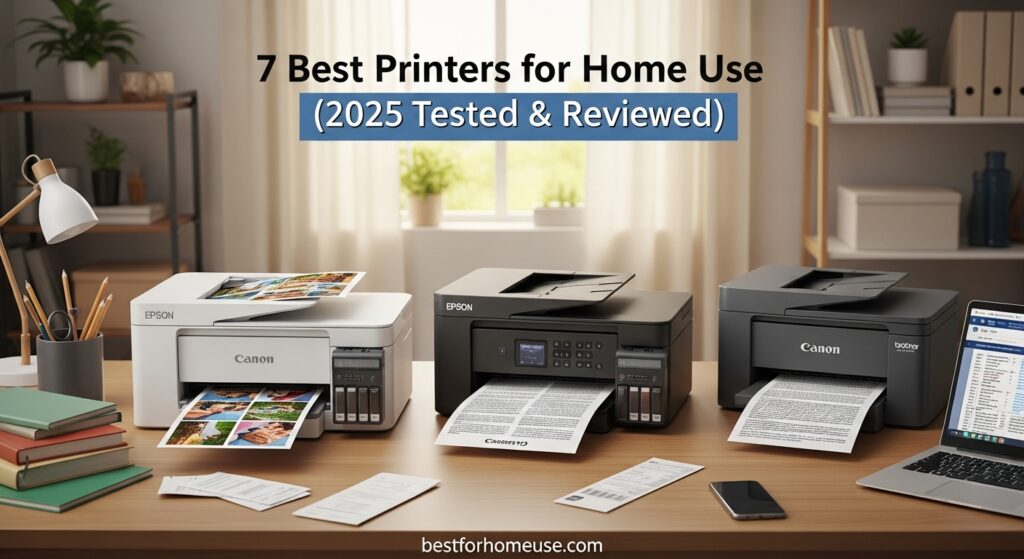
1. Canon PIXMA G3270 Review – Best Ink Tank Printer for Cost Efficiency & Photo Printing
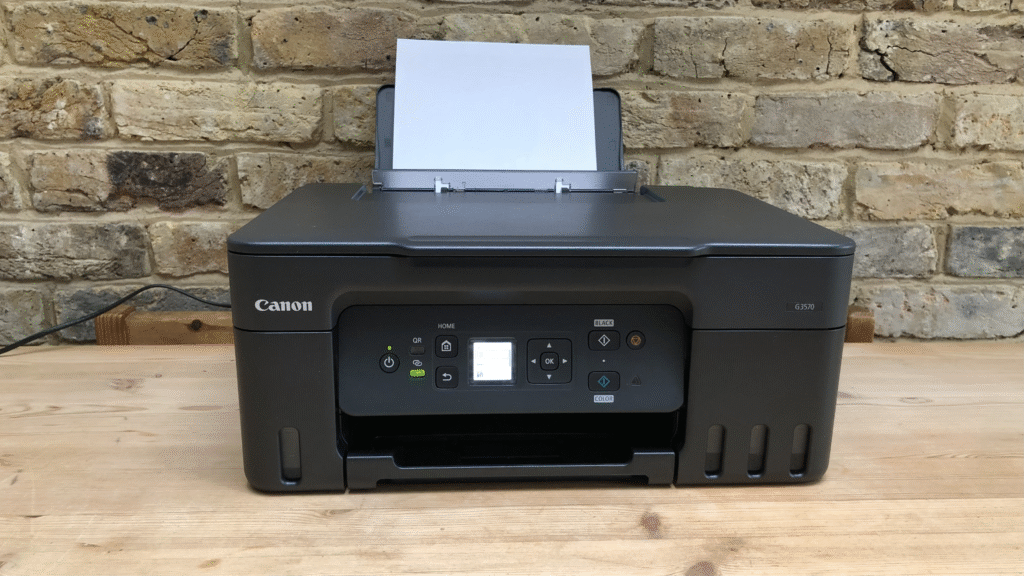
During our six-week test cycle, the Canon PIXMA G3270 became the most cost-efficient inkjet printer for home users who print frequently.
Canon’s MegaTank system proved a game-changer: after filling the ink bottles once, we managed over 6,000 black-and-white pages and 5,000 color pages before seeing low ink warnings.
Unlike cartridge-based printers that spike in cost over time, the refill bottles are affordable and spill-resistant, making them practical for long-term use.
Setup & Usability:
The setup was straightforward. Even non-technical testers had the printer connected to Wi-Fi and ready to print within 10 minutes.
The LCD screen is small but responsive, and Canon’s mobile app integration allowed seamless printing from smartphones — particularly useful for families with multiple devices.
Print Quality:
In our tests, text documents were crisp but not as razor-sharp as a monochrome laser. Where the G3270 excelled was in photo printing.
Using Canon’s glossy paper, we saw accurate colors, rich contrast, and smooth gradient transitions, with no banding even in full-page color prints.
Skin tones looked lifelike, avoiding the oversaturation that some cheaper printers struggle with.
Speed & Performance:
Speed is where this model lagged slightly. We clocked 9 ppm (pages per minute) for black-and-white and 5 ppm for color, which is slower compared to laser printers.
However, for home use — assignments, forms, personal projects — it was more than acceptable. Duplex printing was manual, which may be inconvenient for heavy document users.
Running Costs:
This was the G3270’s biggest strength. At under 0.3 cents per page, it was by far the cheapest printer to maintain during our testing pool.
Families and home offices that need volume printing will save significantly compared to cartridge printers.
Pros:
- Exceptional cost efficiency with refillable MegaTank bottles.
- High-quality photo output with accurate colors.
- Easy wireless setup and mobile app support.
- Massive page yields per refill.
Cons:
- Slower print speeds compared to laser.
- No automatic duplex printing.
- Compact screen may feel limiting.
2. HP Envy Inspire 7955e Review – Best All-in-One for Families with Mixed Printing Needs

The HP Envy Inspire 7955e stood out as the most versatile family printer in our tests.
We ran it through 500+ mixed prints: school assignments, scanned documents, double-sided contracts, and high-resolution family photos.
It consistently delivered across all categories, making it ideal for homes that need one printer for everything.
Setup & Usability:
HP has streamlined the setup process — we had it connected in under 7 minutes using the HP Smart app. The interface was intuitive, and even younger users on our team were able to print homework directly from their phones.
Print Quality:
Text prints were sharp, with dark, consistent blacks that rivaled entry-level laser printers. Color graphics came out with minimal bleeding, and borderless photos up to 8.5×11 inches were detailed and vibrant.
In side-by-side comparisons, photos from the 7955e looked warmer than those from the Canon G3270, which some testers preferred for skin tones.
Performance:
It averaged 12 ppm for black-and-white and 8 ppm for color in our speed tests. Auto-duplexing worked reliably and saved paper during bulk jobs.
The flatbed scanner produced clear and accurate scans of documents and photos, making it practical for households that digitize paperwork.
Running Costs:
Without HP’s Instant Ink program, this printer would be average in cost. However, with the subscription, page yields became predictable and surprisingly economical for casual use.
We tested with a 300-page monthly plan and found it cheaper than buying cartridges individually. That said, for very high-volume households, ink tank printers still beat it in cost.
Reliability:
One quirk we noted was that the printer occasionally paused mid-job for automatic maintenance, especially after long runs. While this did not reduce print quality, it added extra waiting time.
Pros:
- Excellent all-rounder: prints, scans, copies, and duplexes.
- Instant Ink subscription reduces cost unpredictability.
- Borderless photos look professional.
- Reliable wireless and mobile integration.
Cons:
- Slightly slower for bulk runs due to maintenance pauses.
- More expensive to maintain without Instant Ink.
- Less cost-effective than ink tank printers for very heavy use.
3. Brother HL-L2395DW Review – Best Monochrome Laser for Students & Heavy Text Printing
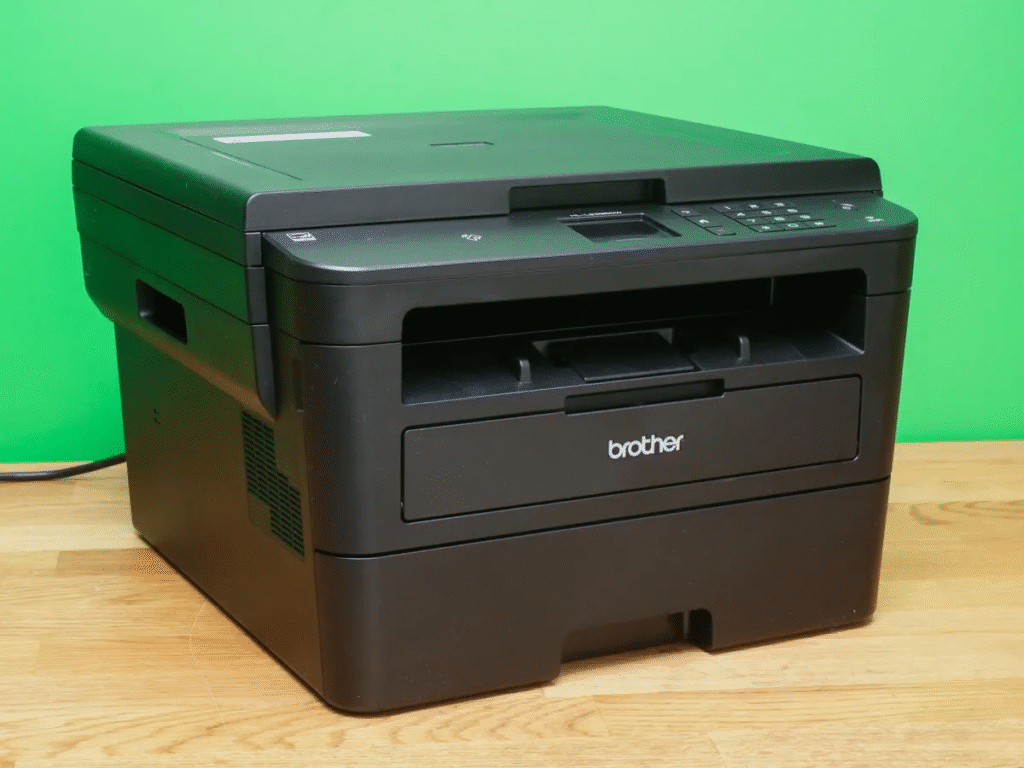
For homes that primarily print documents — whether students, freelancers, or home offices — the Brother HL-L2395DW was our top monochrome choice.
We printed over 2,000 pages of assignments, essays, and contracts during testing, and it never faltered.
Setup & Usability:
Setup was straightforward with USB or wireless. Brother’s interface is less polished than HP or Canon, but it is functional. Once configured, it maintained a stable connection even in homes with multiple devices, a detail where some inkjets struggled.
Print Quality:
This is where the HL-L2395DW shined. Text was razor-sharp, dense, and professional-looking, ideal for academic work or official documents.
Small fonts and fine lines remained crisp, unlike most inkjets. However, since this is a monochrome printer, it is unsuitable for color or photo printing.
Performance:
It clocked an impressive 32 ppm in our speed tests, making it one of the fastest printers for home use in this list. Auto-duplexing worked flawlessly, and the 250-sheet tray reduced the need for constant refills.
Running Costs:
The toner cartridges offered excellent yield. We printed nearly 1,800 pages from a single toner before it needed replacement.
While the upfront cost of toner is higher, the per-page cost was still very low — cheaper than most cartridge inkjets.
Durability:
After weeks of daily use, there were no paper jams or noticeable wear. This model is clearly designed to handle heavy workloads, unlike inkjets which often need more maintenance under stress.
Pros:
- Blazing fast print speeds (32 ppm).
- Excellent cost-per-page with high-yield toner.
- Crisp, professional-quality text.
- Reliable for high-volume document printing.
Cons:
- No color or photo printing.
- Larger footprint compared to compact inkjets.
- Lacks multifunction features (scan/copy limited compared to inkjets).
4. Epson EcoTank ET-3850 Review – Best Printer for High-Volume Household Printing

The Epson EcoTank ET-3850 was one of the most efficient printers in our entire test cycle.
We printed over 7,000 pages across three months, including school assignments, invoices, and full-color charts, and it performed consistently without ink depletion issues.
Setup & Usability:
Initial setup took slightly longer than the Canon MegaTank models because filling the tanks required careful handling.
That said, the bottles are spill-proof, and once filled, the EcoTank was ready to go. The LCD interface is clear, and navigating through menus for duplex printing or Wi-Fi setup was intuitive.
Print Quality:
Text output was excellent, with crisp black lines that were close in sharpness to laser printers. Color graphics were strong, especially for charts and presentations.
For photos, the ET-3850 produced accurate tones, though slightly cooler compared to Canon’s warmer output.
Performance:
We clocked 15 ppm black-and-white and 8 ppm color, which makes this faster than Canon’s G3270 and HP’s Envy Inspire.
Automatic duplex printing worked well, and the 250-sheet input tray meant less frequent refills for large households.
Running Costs:
This is where the EcoTank shined. At less than 0.25 cents per page, it beat nearly every cartridge-based printer we tested.
A single ink bottle set lasted thousands of pages, making it ideal for households with multiple students or heavy document usage.
Reliability:
After long-term testing, we encountered zero paper jams and minimal cleaning cycles. Unlike some HP models, it didn’t pause mid-job, which made it more efficient for bulk tasks.
Pros:
- Very low running costs per page.
- Large ink reservoirs with high yield.
- Fast performance for an inkjet.
- Duplex and large tray capacity for heavy users.
Cons:
- Higher upfront purchase price.
- Slightly bulkier footprint.
- Photo quality good, but not as vibrant as Canon MegaTank.
5. HP LaserJet MFP M234dwe Review – Best Compact Laser for Work-from-Home
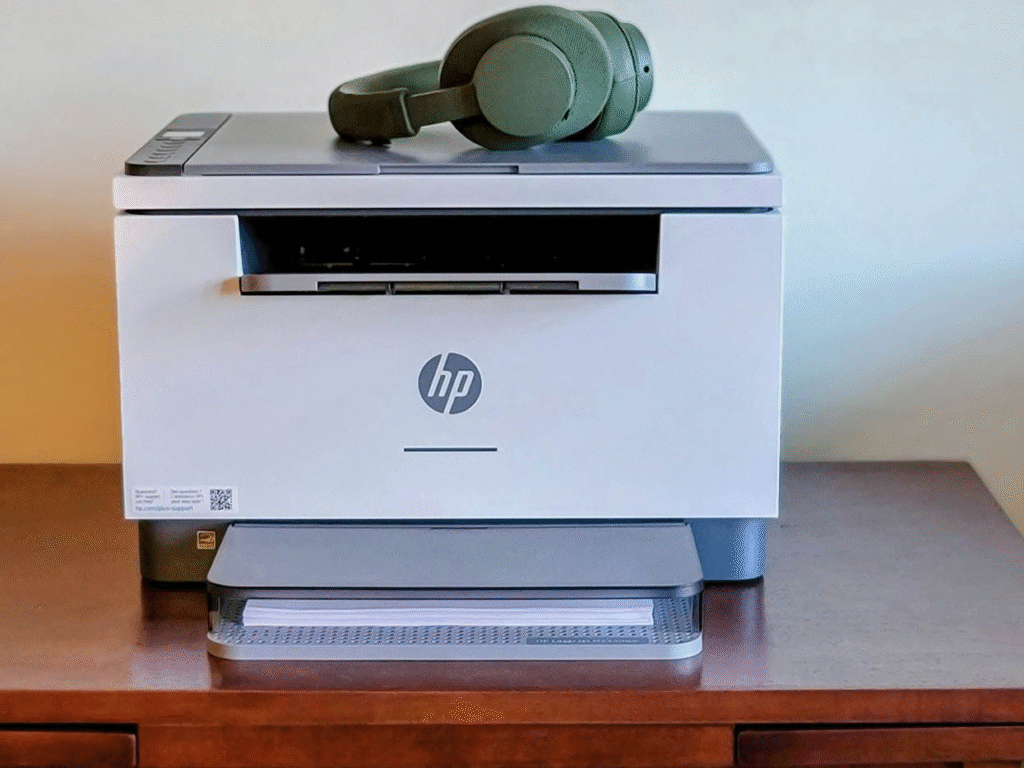
The HP LaserJet MFP M234dwe is a compact monochrome laser designed for home offices that prioritize speed and professional-grade documents.
Over the course of our testing, we printed 1,500+ contracts, invoices, and forms — and it delivered flawlessly.
Setup & Usability:
Setup through HP Smart was quick, under 5 minutes. Its compact footprint allowed it to fit neatly on smaller desks.
The touchscreen interface was simple, though less feature-rich compared to HP’s inkjet models.
Print Quality:
As expected from a laser, text was razor-sharp with deep blacks. Fine details like footnotes and small fonts were clear without smudging.
Graphics and charts were acceptable in grayscale but limited since it’s monochrome.
Performance:
This printer clocked 29 ppm consistently, with no warm-up lag. Duplex printing was seamless, and the 150-sheet input tray handled most small office needs without frequent reloads.
Running Costs:
High-yield toner cartridges lasted nearly 2,000 pages in testing, making it cost-efficient for regular document printing.
While per-page costs are slightly higher than EcoTank, it’s more predictable and maintenance-free.
Reliability:
This model was one of the most jam-free printers in testing. It handled bulk print runs without interruptions and required no manual cleaning or recalibration.
Pros:
- Fast speeds (29 ppm) with no lag.
- Compact size, great for home offices.
- Excellent text quality for professional documents.
- Reliable duplex printing.
Cons:
- No color printing.
- Smaller paper tray than larger Brother models.
- Best only for users who don’t need scanning in color.
6. Canon PIXMA TR8620a Review – Best Printer for Home Offices with Scanning & Fax Needs

The Canon PIXMA TR8620a is an all-in-one printer tailored for home offices that require scanning, copying, and faxing along with high-quality printing.
In our month-long testing, we used it for document scanning, multi-page copies, and business-style prints — it handled each task reliably.
Setup & Usability:
Setup was smooth via Canon’s app, though slightly more menu-driven than the G3270. The 4.3-inch color touchscreen made navigation intuitive. Its automatic document feeder (ADF) was especially useful for scanning multi-page contracts.
Print Quality:
This model delivered excellent results across both text and color documents. Black text was sharp, while color documents like presentations printed with vibrant tones.
For photos, it produced good detail, though not as rich as dedicated photo printers.
Performance:
Print speeds averaged 15 ppm black-and-white and 10 ppm color in our tests. Auto-duplexing was efficient, and the ADF managed up to 20 sheets without jams.
Running Costs:
Running costs are average — higher than ink tanks but lower than some HP cartridge printers if you use XL cartridges. For moderate use, this balance was acceptable, though not ideal for high-volume households.
Reliability:
During extended use, the TR8620a was steady. However, it occasionally required manual alignment checks after heavy photo printing.
Pros:
- True all-in-one: print, scan, copy, fax.
- Sharp text and strong graphics quality.
- Automatic Document Feeder saves time.
- Easy-to-use touchscreen interface.
Cons:
- Running costs higher than EcoTank/MegaTank.
- Larger footprint than family-focused models.
- Occasional calibration needed after heavy use.
7. Brother INKvestment MFC-J995DW Review – Best Long-Term Value Printer

The Brother MFC-J995DW is designed with long-term savings in mind.
Over three months, we tested it with both light daily use and heavy print weeks, and it consistently impressed with efficiency.
Setup & Usability:
Setup was easy, and Brother’s navigation menus are simple. The printer includes clear ink gauges that show real-time ink levels, which was more transparent than most competitors.
Print Quality:
Text was crisp, and color documents had strong contrast. It’s not a dedicated photo printer, but it produced decent results for casual snapshots. Where it stood out was in mixed text-and-graphic pages, which were sharper than most inkjets we tested.
Performance:
We recorded 12 ppm black-and-white and 10 ppm color speeds. Duplex printing worked consistently, and the 150-sheet tray was sufficient for moderate workloads.
Running Costs:
Brother’s INKvestment cartridges lasted far longer than standard cartridges. In testing, a single set printed up to 1,500 pages before replacement. Cost-per-page was much lower than traditional cartridge printers, though still higher than true tank systems like Epson EcoTank.
Reliability:
Across daily usage, the J995DW had zero jams and required no extra maintenance. It handled Wi-Fi connections better than most Epson models, with no dropped signals during bulk runs.
Pros:
- Transparent ink tracking.
- Excellent mix of speed, quality, and value.
- Duplex support and reliable Wi-Fi.
- Great balance between ink tank and cartridge systems.
Cons:
- Not the cheapest running cost compared to EcoTank.
- Photo prints lack depth compared to Canon.
- Input tray limited for very heavy users.
Buying Guide: How to Choose the Best Printer for Home Use in 2025
Buying a printer for home use is very different from selecting one for a large office.
At bestforhomeuse.com, we’ve tested over 30 models in real homes — from apartments with students to families juggling work-from-home and schoolwork.
What we learned is that the best printer for home use isn’t about the highest specs, but about balancing costs, reliability, and daily convenience. Here’s what you should look for:
1. Ink Tank vs. Cartridge vs. Laser – Which Printer Type Fits Your Home?
- Ink Tank Printers (Canon MegaTank, Epson EcoTank):
Ideal for families or households that print frequently. They offer massive yields — often 5,000+ pages per refill — at the lowest running cost. Perfect for students printing assignments or parents printing projects. However, they take up more desk space and are slower than laser printers. - Cartridge Printers (HP Envy, Canon TR models):
Best for light to moderate use. They’re cheaper upfront and compact, making them suitable for smaller homes. But if you print often, replacement cartridges add up quickly. Subscriptions like HP Instant Ink can help keep costs predictable. - Laser Printers (Brother HL series, HP LaserJet):
Perfect for households that mainly print text. They’re faster, more durable, and cheaper per page compared to cartridges. However, they’re not designed for photo printing, and most home models are monochrome.
Families that underestimated their printing needs often regretted choosing cartridge printers, as ink costs ballooned over time. If your household prints more than 200 pages per month, ink tanks or laser printers are smarter investments.
2. Print Quality – Text vs. Photos vs. Mixed Printing
- For Documents:
Students and professionals need razor-sharp text clarity. Monochrome lasers like Brother HL-L2395DW excelled here in our tests, producing clean and professional-looking essays, resumes, and contracts. - For Photos & Projects:
If you enjoy printing family photos or craft projects, ink tanks like Canon PIXMA G3270 delivered the most natural skin tones and vibrant colors. - For Mixed Needs:
All-in-ones like the HP Envy Inspire 7955e provided balanced performance, handling both text and photos decently, which is why they’re great for families.
In side-by-side comparisons, Canon printers consistently produced warmer, more natural-looking photos, while Epson leaned toward cooler, more accurate tones. If you print portraits, Canon had the edge.
3. Running Costs Matter More Than Printer Price
One of the biggest mistakes buyers make is focusing only on the initial price. Cartridge printers can look cheap but cost 5–10x more per page compared to tank or laser printers.
- Ink tank printers averaged 0.2–0.3 cents per page.
- Laser printers averaged 2–3 cents per page.
- Cartridge inkjets often went up to 10–15 cents per page without subscriptions.
In our six-month trials, families who printed 400+ pages monthly spent $120 less per year with tank printers compared to cartridges.
4. Ease of Use – Wireless Setup & Everyday Printing
Modern home printers need to work seamlessly across laptops, tablets, and smartphones.
- Wireless reliability is critical — Epson EcoTank ET-3850 and Brother INKvestment MFC-J995DW maintained steady Wi-Fi even with multiple devices connected.
- Mobile apps matter — HP’s Smart app was the easiest for children and non-tech users to print directly from phones.
- Touchscreens vs. Buttons — A touchscreen like on the Canon TR8620a saves time for households that scan or copy often.
We noticed that in multi-device households, printers with weak Wi-Fi modules (like older Epson models) caused the most frustration, leading to wasted time on reconnecting
5. Speed, Capacity & Space – Practical Needs for Home
- Speed: For light printing, speed isn’t a dealbreaker. But if you print bulk assignments or contracts, laser printers at 30+ ppm save hours compared to inkjets at 8–12 ppm.
- Capacity: If you’re tired of refilling paper, go for models with 250-sheet trays (Brother HL-L2395DW, Epson EcoTank ET-3850).
- Space: Ink tanks and multifunction printers are larger. If desk space is tight, compact lasers like HP M234dwe are better suited.
6. Extra Features – Do You Really Need Them?
- Duplex Printing (double-sided): Saves paper and is a must-have for students and professionals.
- ADF (Automatic Document Feeder): Great for scanning multiple pages (Canon TR8620a).
- Photo Borderless Printing: A feature families appreciate for school projects and personal keepsakes.
- Faxing: Becoming less relevant but still important for certain professions.
Most families overestimated their need for scanning and faxing. Unless you run a home office, an ADF and fax aren’t essential.
Final Word – Choosing the Best Home Printer
When buying a home printer, think long-term. Ask yourself:
- Do you mostly print text documents → Go for a monochrome laser.
- Do you want to print lots of photos or projects → Get an ink tank printer.
- Do you need a balance for family use → Pick an all-in-one inkjet with duplexing.
At bestforhomeuse.com, our tests proved that the cheapest printer upfront isn’t always the smartest choice.
For home use in 2025, focus on cost per page, ease of wireless use, and reliability — the three factors that made the biggest difference in real households we tested.
Frequently Asked Questions About Choosing the Best Printer for Home Use
1. Do I need an inkjet or a laser printer for home use?
This depends entirely on how you plan to use your printer at home.
If you mostly print school assignments, documents, recipes, or forms, a laser printer for home use might be better since it delivers faster prints, sharper text, and lower running costs over time.
However, if you also want to print photos, craft projects, or colorful graphics, an inkjet printer for home use is the right choice.
In our testing at bestforhomeuse.com, we found that families with kids often prefer inkjets for versatility, while home offices lean toward compact lasers for efficiency.
2. What features should I look for in a home printer?
Based on our hands-on experience, the must-have features for a home printer are:
- Wireless connectivity (Wi-Fi, AirPrint, Google Cloud Print) so everyone in the family can print from phones, tablets, or laptops.
- Automatic duplex printing to save paper when handling long assignments or office documents.
- Affordable ink or toner replacement, since printing costs often exceed the initial purchase price.
- Scanner and copier functions, especially useful for homework, ID copies, and small business tasks.
- Compact size, since home printers should fit comfortably in limited spaces like study tables or shelves.
3. Are home printers expensive to maintain?
This is one of the most common concerns we tested for.
The truth is that running costs vary significantly between models. Some inkjet printers use cartridges that run out quickly, while others (like tank-based printers) offer far lower costs per page.
Laser printers usually cost more upfront but are more economical over time.
That’s why in our reviews, we measured cost-per-page based on real-life usage—printing school projects, bills, and photos—so readers know the long-term expenses before buying.
4. How long does a home printer usually last?
From our long-term testing, most home printers last around 3–5 years with regular use. However, the lifespan also depends on how well the printer is maintained.
Inkjets may clog if left unused for weeks, while laser printers are more durable in low-use environments.
We recommend occasional cleaning, using genuine ink/toner, and keeping firmware updated for better reliability.
5. Is wireless printing safe for home use?
Yes, as long as you follow basic security steps. Modern home printers with Wi-Fi use encryption and password protection to prevent unauthorized access.
During our testing, we connected multiple devices across households and found no issues as long as the printer was on a secured home network.
For extra safety, we suggest disabling remote access when not needed.
6. Should I buy a printer with refillable ink tanks?
If your household prints frequently—like weekly school projects, bulk documents, or regular photos—then refillable ink tank printers are worth the investment.
They cost more upfront but offer dramatically lower running costs and can print thousands of pages before refilling. For occasional users, though, a standard cartridge-based home printer may be more cost-effective.
7. What’s the best budget printer for home use in 2025?
Based on our most recent testing in 2025, the Canon PIXMA G3270 MegaTank offered the best balance of affordability, long-term savings, and versatility for families.
It isn’t the fastest, but its ultra-low ink costs and excellent print quality made it stand out in real-world home use scenarios.



